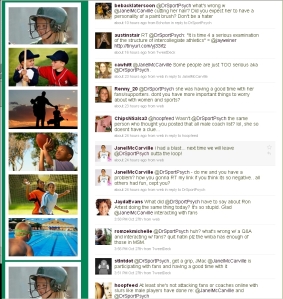I have refrained from weighing in on the Ines Sainz/NY Jets issue thus far because it is complicated and I needed to think about it fully. Many have shared their view points arguing the issue from many angles. Last night I gave a TV interview with our local FOX affiliate and finally weighed in on this subject. To see the interview click here.
The real issue is not whether women should be allowed in male locker rooms. In 1985 the NFL dealt with this issue and granted equal access to credentialed female sport journalists, despite the fact a belief persists among some that females should “stay out.”
The real issue is not about what Sainz was wearing. While it can be argued Sainz was not “dressed appropriately or professionally” that does not give permission for males to harass or act boorishly. I liked Jelisa Castrodale’s take on this issue, she writes, “Disturbingly, the most frequently cited justification for the Jets’ behavior is that Sainz ‘deserved’ whatever comments or catcalls that were launched in her direction, both because she is an attractive woman and because she chose to wear something that fit more snugly than a shower curtain. The ‘she’s askin’ fer it’ excuse has been a longtime favorite of COPS co-stars, domestic court defendants and frat guys on the wrong side of the honor code.”
However, I think that Sainz does not do female sport journalists as a whole any favors by consistently showing up to the workplace/football fields in “clubbing attire.” According to a 2008 report commissioned by the AP Sport Editors, females comprise less than 10% all sport reporters. Given that female sport journalists are statistical tokens (< 15% of a population) they are under constant scrutiny, have to perform above and beyond their male peers to be deemed competent, and are subjected to overt and covert forms of discrimination. The few women who “make it big” and are given access to professional male sport arenas have a responsibility to act professionally above and beyond what is expected so that all females in the industry are respected. As one of my colleagues pointed out when discussing this issue, “Dress for Success” is a cliche for a reason.
I think the real issue underlying the Sainz/Jets situation is that workplace harassment occurred, and we have laws that protect against that. Some of the best pieces I’ve read and agree with are the following:
1. USA Today columnist, Christine Brennan summarized it best when she argued the real issue was workplace harassment. Brennan writes, “Was a credentialed reporter harassed in the workplace by the team that gave her that credential? Everything else about this story is extraneous.” To read her piece, click here.
2. The Association for Women in Sport Media also released position statements which debunked myths and outlined why this is a harassment case. In an open letter AWSM stated, “AWSM sees this as a simple issue: Sainz was granted a media credential by the New York Jets. She was working in an official capacity for her employer, TV Azteca in Mexico. Once she was credentialed, she deserved not only equal access but also the right to a work environment free from harassment and hostility.
I also found it interesting that some tried to explain away, justify, or excuse the behavior of the Jets players and coaches by saying “boys will be boys.” If harassment of women in the workplace by men is explained as “boys will be boys” than that is a sad reflection of the sign of the times. Unfortunately this language is used repeatedly to normalize or minimize the bad behavior of males. Most importantly these were not boys, they were grown men. Why is it still a common occurrence that some men still think nothing of treating women as sexual objects in the workplace…it is 2010 right?









